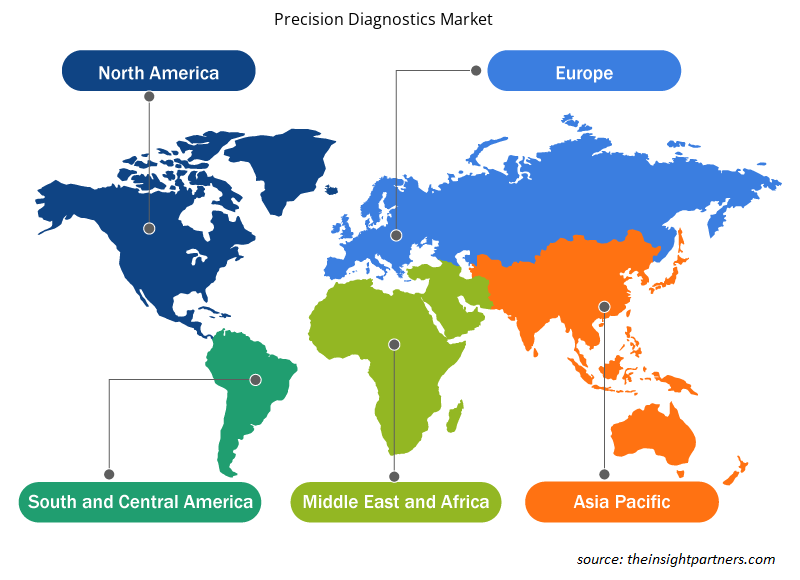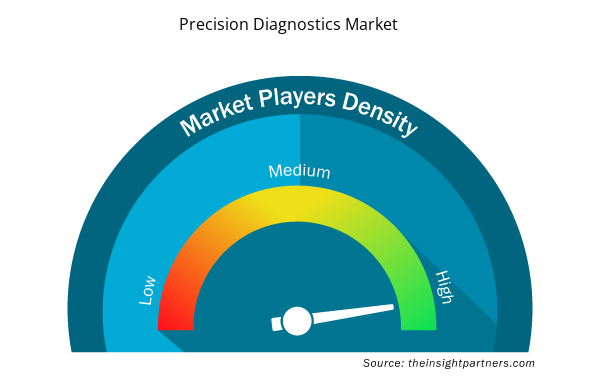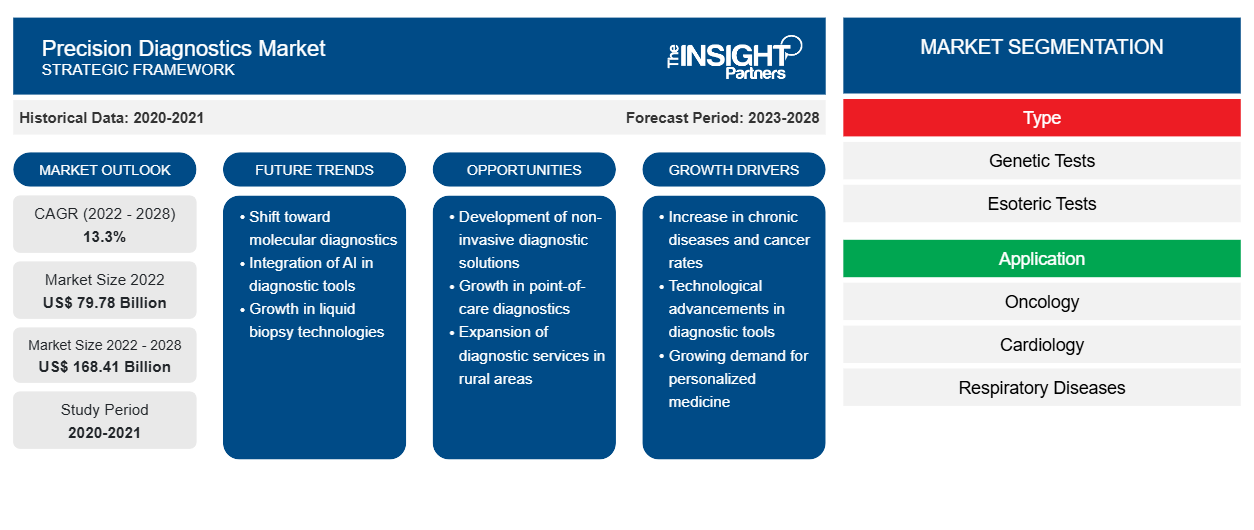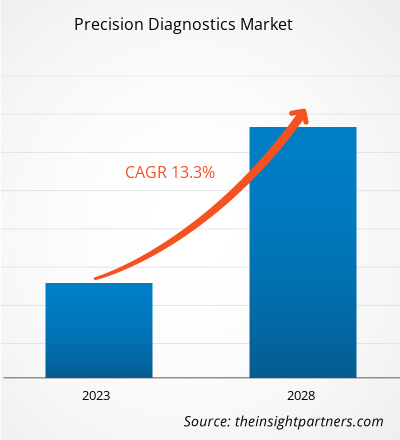[Rapport de recherche] Le marché du diagnostic de précision devrait atteindre 168 405,71 millions USD d'ici 2028, contre 79 776,88 millions USD en 2022 ; il devrait croître à un TCAC de 13,3 % de 2022 à 2028.
Les diagnostics de précision sont des méthodes de diagnostic des maladies qui expliquent l'état du patient de manière détaillée et précise. Ils aident les professionnels de la santé à réaliser des procédures de traitement de manière efficace et efficiente. Ils sont utilisés pour guérir le diabète, le cancer et d'autres troubles à l'aide de divers tests, notamment des tests ésotériques, des tests génétiques et autres.
Le marché du diagnostic de précision est segmenté en fonction du type, de l’application, de l’utilisateur final et de la géographie. Par géographie, le marché est segmenté en Amérique du Nord, Europe, Asie-Pacifique, Moyen-Orient et Afrique et SAM. Le rapport sur le marché du diagnostic de précision offre des informations et une analyse approfondie du marché, en mettant l’accent sur des paramètres tels que la taille du marché, les tendances, les avancées technologiques et la dynamique du marché. Il fournit également une analyse du paysage concurrentiel des principaux acteurs du marché à travers le monde. En outre, le rapport inclut l’impact de la pandémie de COVID-19 sur le marché du diagnostic de précision dans toutes les régions.
Personnalisez ce rapport en fonction de vos besoins
Vous bénéficierez d'une personnalisation gratuite de n'importe quel rapport, y compris de certaines parties de ce rapport, d'une analyse au niveau des pays, d'un pack de données Excel, ainsi que de superbes offres et réductions pour les start-ups et les universités.
- Obtenez les principales tendances clés du marché de ce rapport.Cet échantillon GRATUIT comprendra une analyse de données, allant des tendances du marché aux estimations et prévisions.
La croissance du marché du diagnostic de précision est due au nombre croissant d'études en cours visant à développer un nouveau traitement contre le cancer et aux initiatives gouvernementales visant à sensibiliser les agents de santé communautaires au diagnostic de précision. Cependant, le coût élevé associé au diagnostic et à la médecine de précision limite la croissance du marché.
Perspectives du marché
L'augmentation des applications en oncologie et dans d'autres domaines stimule la croissance du marché des diagnostics de précision
Le concept de médecine de précision est appliqué de manière robuste dans le traitement des maladies rares. Bien qu'il soit plus populaire en oncologie , il s'étend progressivement à d'autres spécialités. La prévalence croissante du cancer et l'incidence croissante des troubles neurologiques rares augmentent la demande de médecine de précision, ce qui stimule la croissance du marché mondial du diagnostic de précision. En outre, selon la Neurological Alliance, environ 14,7 millions de cas neurologiques ont été enregistrés en 2019, avec au moins 1 personne sur 6 souffrant d'une ou plusieurs affections neurologiques. Selon le National Cancer Institute, le nombre de nouveaux cas de cancer devrait atteindre 29,5 millions d'ici 2040, et les décès liés au cancer augmenteront de 16,4 millions. Selon l'Organisation mondiale de la santé (OMS), la maladie d'Alzheimer, la forme de démence la plus courante, contribue à près de 60 à 70 % des cas. En outre, en septembre 2021, plus de 55 millions de personnes vivaient avec une démence dans le monde, ce qui représente près de 10 millions de nouveaux cas par an. En outre, la demande croissante de procédures de traitement en oncologie et dans d’autres troubles entraîne une augmentation de l’adoption de ces procédures de traitement.
En outre, le nombre croissant de collaborations stratégiques entre sociétés biopharmaceutiques pour développer des médicaments destinés à traiter un groupe spécifique de patients en fonction de leurs besoins spécifiques et pour fournir des procédures et des services de traitement efficaces augmente le nombre d'essais cliniques. Par exemple, Personal Genome Diagnostics Inc. et le Massachusetts General Hospital ont collaboré pour faire progresser le développement de services de traitement efficaces en 2021. En avril 2022, le Precision Cancer Consortium (PCC) a été créé en tant que nouvelle collaboration de sociétés pharmaceutiques ayant pour vision commune de fournir des tests complets à tous les patients atteints de cancer dans le monde. Ainsi, l'augmentation des applications en oncologie et dans d'autres troubles stimule la croissance du marché du diagnostic de précision.biopharmaceutical companies to develop medicines targeted to treat a specific group of patients based on their specific needs and to provide effective treatment procedures and services is increasing the number of clinical trials. For instance, Personal Genome Diagnostics Inc. and Massachusetts General Hospital collaborated to advance the development of effective treatment services in 2021. In April 2022, the Precision Cancer Consortium (PCC) is formed as a new collaboration of pharmaceutical companies with a shared vision of providing comprehensive testing to all cancer patients worldwide. Thus, rising application in oncology and other disorders drives precision diagnostics market growth.
Informations basées sur les types
En fonction du type, le marché du diagnostic de précision est segmenté en tests génétiques, tests ésotériques et autres. En 2022, le segment des tests génétiques détient la plus grande part du marché. De plus, le même segment devrait enregistrer le TCAC le plus élevé de 13,8 % au cours de la période de prévision.CAGR of 13.8 % during the forecast period.
Informations basées sur les applications
En fonction des applications, le marché du diagnostic de précision est segmenté en oncologie, cardiologie, maladies respiratoires, immunologie et autres. Le segment de l'oncologie détient la plus grande part de marché en 2022. De plus, le même segment devrait enregistrer le TCAC le plus élevé de 13,8 % au cours de la période de prévision.CAGR of 13.8% during the forecast period.
Informations basées sur l'utilisateur final
En fonction de l'utilisateur final, le marché du diagnostic de précision est segmenté en laboratoires cliniques, hôpitaux, soins à domicile et autres. Le segment des laboratoires cliniques détient la plus grande part de marché en 2022. De plus, le même segment devrait enregistrer le TCAC le plus élevé de 13,8 % au cours de la période de prévision.
Les acteurs du marché du diagnostic de précision se concentrent sur l’adoption de stratégies organiques, y compris le lancement et l’expansion de produits, pour étendre leur empreinte et leur portefeuille de produits dans le monde entier et répondre aux demandes croissantes.
Plateforme de gestion d'événements
Aperçu régional du marché du diagnostic de précision
Les tendances et facteurs régionaux influençant le marché du diagnostic de précision tout au long de la période de prévision ont été expliqués en détail par les analystes d’Insight Partners. Cette section traite également des segments et de la géographie du marché du diagnostic de précision en Amérique du Nord, en Europe, en Asie-Pacifique, au Moyen-Orient et en Afrique, ainsi qu’en Amérique du Sud et en Amérique centrale.

- Obtenez les données régionales spécifiques au marché du diagnostic de précision
Portée du rapport sur le marché du diagnostic de précision
| Attribut de rapport | Détails |
|---|---|
| Taille du marché en 2022 | 79,78 milliards de dollars américains |
| Taille du marché d'ici 2028 | 168,41 milliards de dollars américains |
| Taux de croissance annuel composé mondial (2022-2028) | 13,3% |
| Données historiques | 2020-2021 |
| Période de prévision | 2023-2028 |
| Segments couverts | Par type
|
| Régions et pays couverts | Amérique du Nord
|
| Leaders du marché et profils d'entreprises clés |
|
Densité des acteurs du marché du diagnostic de précision : comprendre son impact sur la dynamique commerciale
Le marché du diagnostic de précision connaît une croissance rapide, tirée par la demande croissante des utilisateurs finaux en raison de facteurs tels que l'évolution des préférences des consommateurs, les avancées technologiques et une plus grande sensibilisation aux avantages du produit. À mesure que la demande augmente, les entreprises élargissent leurs offres, innovent pour répondre aux besoins des consommateurs et capitalisent sur les tendances émergentes, ce qui alimente davantage la croissance du marché.
La densité des acteurs du marché fait référence à la répartition des entreprises ou des sociétés opérant sur un marché ou un secteur particulier. Elle indique le nombre de concurrents (acteurs du marché) présents sur un marché donné par rapport à sa taille ou à sa valeur marchande totale.
Les principales entreprises opérant sur le marché du diagnostic de précision sont :
- Quest Diagnostics Incorporated
- QIAGEN
- Diagnostics de précision suisses SARL
- Royal Philips NV
- Lantheus Medical Imaging, Inc.
Avis de non-responsabilité : les sociétés répertoriées ci-dessus ne sont pas classées dans un ordre particulier.

- Obtenez un aperçu des principaux acteurs du marché du diagnostic de précision
Par géographie
Sur la base de la géographie, le marché du diagnostic de précision est segmenté en Amérique du Nord (États-Unis, Canada et Mexique), Europe (Royaume-Uni, Allemagne, France, Italie, Espagne et reste de l'Europe), Asie-Pacifique (Chine, Japon, Inde, Australie, Corée du Sud et reste de l'Asie-Pacifique), Moyen-Orient et Afrique (EAU, Arabie saoudite, Afrique du Sud et reste du Moyen-Orient et de l'Afrique) et Amérique du Sud et centrale (Brésil, Argentine et reste de l'Amérique du Sud et centrale).
Profils d'entreprise
- Quest Diagnostics Incorporated
- QIAGEN
- Diagnostics de précision suisses SARL
- Royal Philips NV
- Lantheus Medical Imaging, Inc.
- Siemens Healthineers SA
- Abbott
- Novartis SA
- Sanofi
- Bayer AG
- Analyse historique (2 ans), année de base, prévision (7 ans) avec TCAC
- Analyse PEST et SWO
- Taille du marché Valeur / Volume - Mondial, Régional, Pays
- Industrie et paysage concurrentiel
- Ensemble de données Excel



Report Coverage
Revenue forecast, Company Analysis, Industry landscape, Growth factors, and Trends

Segment Covered
This text is related
to segments covered.

Regional Scope
North America, Europe, Asia Pacific, Middle East & Africa, South & Central America

Country Scope
This text is related
to country scope.
Questions fréquemment posées
Precision diagnostics are disease diagnosis methods that explain the patient’s condition in a detailed and precise manner. It helps healthcare professionals to carry out treatment procedures in an effective and efficient manner. It is used to cure diabetes, cancer, and other disorders using various diagnostics tests.
The factors that are driving the growth of market are increasing demands of precision medicines and rising application of precision diagnostics. However, high investments involved in the R&D of precision medicine and diagnostic kits is the major factor hindering the precision diagnostics market growth.
The precision diagnostics market majorly consists of the players, such as Quest Diagnostics Incorporated; QIAGEN; Swiss Precision Diagnostics GmbH; Koninklijke Philips N.V.; Lantheus Medical Imaging, Inc.; Siemens Healthineers AG; Abbott; Novartis AG; Sanofi; and Bayer AG.
The market is estimated to grow at a CAGR of 13.3% during the forecast period.
The precision diagnostics market is estimated to be valued at US$ 79,776.88 million in 2022.
The precision diagnostics market is expected to be valued at US$ 168,405.71 million in 2028.
North America accounts for the major market share of precision diagnostics market in 2022 due to increasing prevalence of cancer and chronic cases in the region and increasing initiatives by government and companies operating in the country.
The colorectal cancer market is analyzed in the basis of type, application, and end user. Based on type, the market is segmented into genetic tests, esoteric tests, and others. The genetic tests segment held the largest share of the market. Moreover, the same segment is anticipated to register the highest CAGR in the forecast period.
Asia Pacific is expected to be the fastest growing region in precision diagnostics market over the forecast period due to developing healthcare infrastructure, enormous population base, growing prevalence of chronic diseases, growing government efforts, and technological improvement in the sector.
Trends and growth analysis reports related to Life Sciences : READ MORE..
The List of Companies - Precision Diagnostics Market
- Quest Diagnostics Incorporated
- QIAGEN
- Swiss Precision Diagnostics GmbH
- Koninklijke Philips N.V.
- Lantheus Medical Imaging, Inc.
- Siemens Healthineers AG
- Abbott
- Novartis AG
- Sanofi
- Bayer AG
The Insight Partners performs research in 4 major stages: Data Collection & Secondary Research, Primary Research, Data Analysis and Data Triangulation & Final Review.
- Data Collection and Secondary Research:
As a market research and consulting firm operating from a decade, we have published and advised several client across the globe. First step for any study will start with an assessment of currently available data and insights from existing reports. Further, historical and current market information is collected from Investor Presentations, Annual Reports, SEC Filings, etc., and other information related to company’s performance and market positioning are gathered from Paid Databases (Factiva, Hoovers, and Reuters) and various other publications available in public domain.
Several associations trade associates, technical forums, institutes, societies and organization are accessed to gain technical as well as market related insights through their publications such as research papers, blogs and press releases related to the studies are referred to get cues about the market. Further, white papers, journals, magazines, and other news articles published in last 3 years are scrutinized and analyzed to understand the current market trends.
- Primary Research:
The primarily interview analysis comprise of data obtained from industry participants interview and answers to survey questions gathered by in-house primary team.
For primary research, interviews are conducted with industry experts/CEOs/Marketing Managers/VPs/Subject Matter Experts from both demand and supply side to get a 360-degree view of the market. The primary team conducts several interviews based on the complexity of the markets to understand the various market trends and dynamics which makes research more credible and precise.
A typical research interview fulfils the following functions:
- Provides first-hand information on the market size, market trends, growth trends, competitive landscape, and outlook
- Validates and strengthens in-house secondary research findings
- Develops the analysis team’s expertise and market understanding
Primary research involves email interactions and telephone interviews for each market, category, segment, and sub-segment across geographies. The participants who typically take part in such a process include, but are not limited to:
- Industry participants: VPs, business development managers, market intelligence managers and national sales managers
- Outside experts: Valuation experts, research analysts and key opinion leaders specializing in the electronics and semiconductor industry.
Below is the breakup of our primary respondents by company, designation, and region:

Once we receive the confirmation from primary research sources or primary respondents, we finalize the base year market estimation and forecast the data as per the macroeconomic and microeconomic factors assessed during data collection.
- Data Analysis:
Once data is validated through both secondary as well as primary respondents, we finalize the market estimations by hypothesis formulation and factor analysis at regional and country level.
- Macro-Economic Factor Analysis:
We analyse macroeconomic indicators such the gross domestic product (GDP), increase in the demand for goods and services across industries, technological advancement, regional economic growth, governmental policies, the influence of COVID-19, PEST analysis, and other aspects. This analysis aids in setting benchmarks for various nations/regions and approximating market splits. Additionally, the general trend of the aforementioned components aid in determining the market's development possibilities.
- Country Level Data:
Various factors that are especially aligned to the country are taken into account to determine the market size for a certain area and country, including the presence of vendors, such as headquarters and offices, the country's GDP, demand patterns, and industry growth. To comprehend the market dynamics for the nation, a number of growth variables, inhibitors, application areas, and current market trends are researched. The aforementioned elements aid in determining the country's overall market's growth potential.
- Company Profile:
The “Table of Contents” is formulated by listing and analyzing more than 25 - 30 companies operating in the market ecosystem across geographies. However, we profile only 10 companies as a standard practice in our syndicate reports. These 10 companies comprise leading, emerging, and regional players. Nonetheless, our analysis is not restricted to the 10 listed companies, we also analyze other companies present in the market to develop a holistic view and understand the prevailing trends. The “Company Profiles” section in the report covers key facts, business description, products & services, financial information, SWOT analysis, and key developments. The financial information presented is extracted from the annual reports and official documents of the publicly listed companies. Upon collecting the information for the sections of respective companies, we verify them via various primary sources and then compile the data in respective company profiles. The company level information helps us in deriving the base number as well as in forecasting the market size.
- Developing Base Number:
Aggregation of sales statistics (2020-2022) and macro-economic factor, and other secondary and primary research insights are utilized to arrive at base number and related market shares for 2022. The data gaps are identified in this step and relevant market data is analyzed, collected from paid primary interviews or databases. On finalizing the base year market size, forecasts are developed on the basis of macro-economic, industry and market growth factors and company level analysis.
- Data Triangulation and Final Review:
The market findings and base year market size calculations are validated from supply as well as demand side. Demand side validations are based on macro-economic factor analysis and benchmarks for respective regions and countries. In case of supply side validations, revenues of major companies are estimated (in case not available) based on industry benchmark, approximate number of employees, product portfolio, and primary interviews revenues are gathered. Further revenue from target product/service segment is assessed to avoid overshooting of market statistics. In case of heavy deviations between supply and demand side values, all thes steps are repeated to achieve synchronization.
We follow an iterative model, wherein we share our research findings with Subject Matter Experts (SME’s) and Key Opinion Leaders (KOLs) until consensus view of the market is not formulated – this model negates any drastic deviation in the opinions of experts. Only validated and universally acceptable research findings are quoted in our reports.
We have important check points that we use to validate our research findings – which we call – data triangulation, where we validate the information, we generate from secondary sources with primary interviews and then we re-validate with our internal data bases and Subject matter experts. This comprehensive model enables us to deliver high quality, reliable data in shortest possible time.


 Obtenez un échantillon gratuit pour ce rapport
Obtenez un échantillon gratuit pour ce rapport